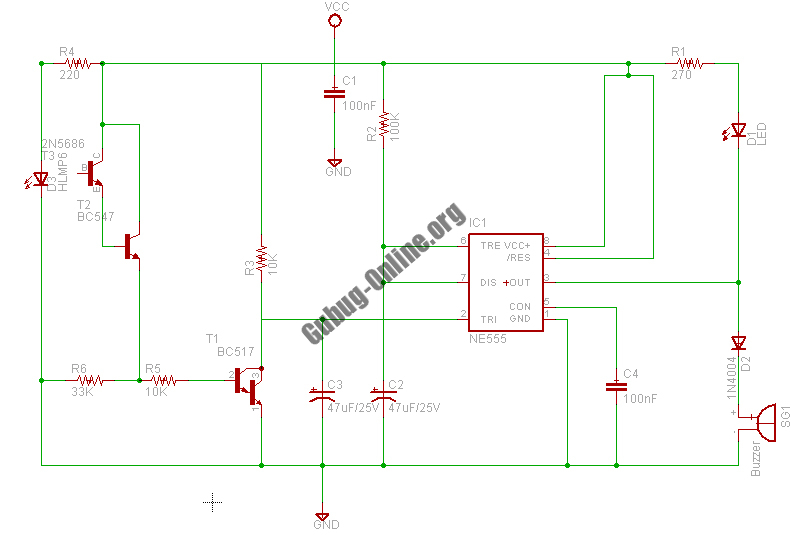
Optocouplers MOC304 dimming control circuit diagram

A dimming control circuit is implemented using a single-chip I/O port sinking method to control a thyristor switch for dimming functionality. The MOC3041 optocoupler features an internal zero-crossing detection circuit, allowing for effective control of the thyristor. This design achieves strong isolation between the control and power circuits. Traditional dimming methods involve phase-triggering of the thyristor and controlling the conduction angle to manage output power. However, these methods often result in complicated synchronous detection circuits and can generate high harmonic interference, which distorts the grid voltage waveform and affects the operation of other electrical devices and communication systems. This system employs a zero-trigger thyristor with a turn-off time ratio to adjust lamp power. The zero-trigger voltage waveform remains unchanged; only the voltage of the full wave is modified, avoiding power grid pollution. The MOC3041's internal zero-crossing detection circuit activates when the output current of 15mA is applied to the input pin. When the voltage across pins 4 and 6 is slightly above zero, the internal bidirectional thyristor triggers the external thyristor. When the input current to the MOC3041 is zero, the internal bidirectional thyristor and the external thyristor turn off.
The described dimming control circuit is designed for efficient and reliable operation in lighting applications. The use of the MOC3041 optocoupler is crucial due to its built-in zero-crossing detection capability, which minimizes electromagnetic interference and harmonics in the power supply. This is particularly beneficial for maintaining the integrity of the electrical grid and ensuring that other connected devices operate without disruption.
The circuit operates by sensing the zero-crossing point of the AC waveform, allowing the control signal to trigger the thyristor at the optimal moment. This timing is essential for reducing flicker in lighting applications and enhancing the overall user experience. The use of a thyristor allows for robust control over the power delivered to the load, enabling smooth dimming from full brightness to complete darkness.
In practical applications, the circuit can be integrated into various lighting systems, including residential and commercial lighting, where dimming capabilities are desired. The design's simplicity and effectiveness make it suitable for a wide range of environments, from homes to industrial settings. Furthermore, the isolation provided by the optocoupler ensures that high voltages do not affect the low-voltage control side of the circuit, enhancing safety and reliability.
Overall, this dimming control circuit exemplifies modern approaches to power management in lighting systems, leveraging solid-state devices for efficient control while mitigating issues associated with traditional dimming methods.Dimming control circuit as shown in FIG. Single-chip I/O port sinking method to achieve control thyristor switch and dimming control. MOC3041 optocoupler with internal zero-cro ssing detection circuit as thyristor drives and to achieve strong, weak isolation. Traditional methods are used dimming phase trigger thyristor, thyristor conduction angle control to control the output power, not only synchronous detection circuit is complicated, but also in the thyristor instantly generate high harmonic interference, causing the grid voltage waveform distortion, influence normal operation of other electrical equipment and communications systems, this system uses zero trigger thyristor with turn-off time ratio to adjust the lamp power, due to the zero trigger voltage waveform does not change but only by changing the voltage of the full wave times, will not pollute the power grid, therefore, the system uses zero trigger mode. MOC3041 contains an internal zero-crossing detection circuit, when the current output of 15mA input pin input 6-pin, 4-pin voltage between a little over zero, the internal bidirectional thyristor, thyristor external trigger, when MOC3041 input pin input current is zero, the internal bidirectional thyristor is turned off, and thus also the external thyristor is turned off.
The described dimming control circuit is designed for efficient and reliable operation in lighting applications. The use of the MOC3041 optocoupler is crucial due to its built-in zero-crossing detection capability, which minimizes electromagnetic interference and harmonics in the power supply. This is particularly beneficial for maintaining the integrity of the electrical grid and ensuring that other connected devices operate without disruption.
The circuit operates by sensing the zero-crossing point of the AC waveform, allowing the control signal to trigger the thyristor at the optimal moment. This timing is essential for reducing flicker in lighting applications and enhancing the overall user experience. The use of a thyristor allows for robust control over the power delivered to the load, enabling smooth dimming from full brightness to complete darkness.
In practical applications, the circuit can be integrated into various lighting systems, including residential and commercial lighting, where dimming capabilities are desired. The design's simplicity and effectiveness make it suitable for a wide range of environments, from homes to industrial settings. Furthermore, the isolation provided by the optocoupler ensures that high voltages do not affect the low-voltage control side of the circuit, enhancing safety and reliability.
Overall, this dimming control circuit exemplifies modern approaches to power management in lighting systems, leveraging solid-state devices for efficient control while mitigating issues associated with traditional dimming methods.Dimming control circuit as shown in FIG. Single-chip I/O port sinking method to achieve control thyristor switch and dimming control. MOC3041 optocoupler with internal zero-cro ssing detection circuit as thyristor drives and to achieve strong, weak isolation. Traditional methods are used dimming phase trigger thyristor, thyristor conduction angle control to control the output power, not only synchronous detection circuit is complicated, but also in the thyristor instantly generate high harmonic interference, causing the grid voltage waveform distortion, influence normal operation of other electrical equipment and communications systems, this system uses zero trigger thyristor with turn-off time ratio to adjust the lamp power, due to the zero trigger voltage waveform does not change but only by changing the voltage of the full wave times, will not pollute the power grid, therefore, the system uses zero trigger mode. MOC3041 contains an internal zero-crossing detection circuit, when the current output of 15mA input pin input 6-pin, 4-pin voltage between a little over zero, the internal bidirectional thyristor, thyristor external trigger, when MOC3041 input pin input current is zero, the internal bidirectional thyristor is turned off, and thus also the external thyristor is turned off.





